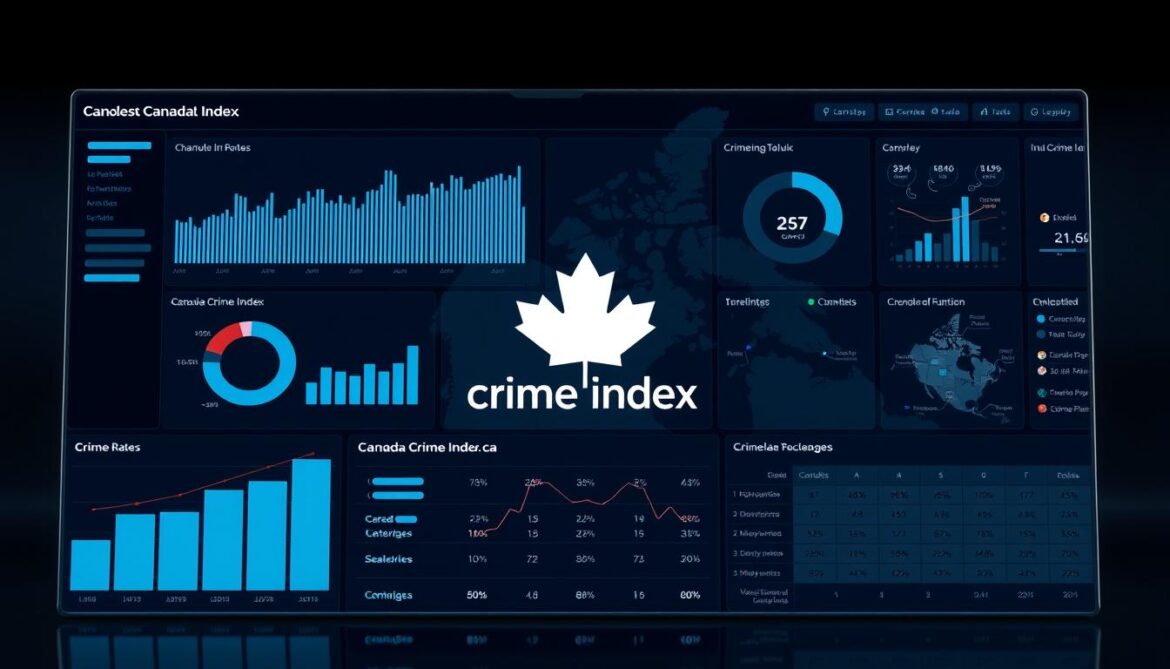Canada, known for its safety, has areas with significantly high crime rates, challenging the country’s overall reputation. According to recent statistics from Statistics Canada, certain regions experience higher risks due to socioeconomic factors, population density, and law enforcement effectiveness.
The Crime Severity Index (CSI) is a crucial metric used to measure and compare crime rates across different Canadian cities and provinces. This analysis will delve into the latest available data to identify areas with the most significant public safety challenges.
By examining both violent and non-violent crime categories, this article aims to provide a nuanced understanding of the complex factors contributing to regional variations in crime rates across Canada.
Understanding Crime Measurement in Canada
Understanding how crime is measured in Canada is crucial for analyzing public safety. Crime measurement involves various indices and statistics that help in assessing the crime situation across different regions.
The Crime Severity Index Explained
The Crime Severity Index (CSI) is a critical metric used by Statistics Canada to measure the crime rate. It takes into account the severity of crimes committed, with more serious offenses weighted more heavily. This index provides a more nuanced understanding of crime trends compared to simple crime rates.
Key aspects of the CSI include:
- Weighting crimes based on their seriousness
- Incorporating both violent and non-violent crimes
- Allowing for comparisons across different regions
Difference Between Violent and Non-Violent Crime Rates
Crime in Canada is broadly categorized into violent and non-violent crimes. Violent crimes, such as homicide, sexual assault, and robbery, involve force or threat against a person. Non-violent or property crimes include theft, fraud, and mischief. The distinction between these categories is crucial for understanding public safety and developing targeted prevention strategies.
| Crime Type | Description | Examples |
|---|---|---|
| Violent Crime | Involves force or threat against a person | Homicide, Sexual Assault, Robbery |
| Non-Violent Crime | Does not involve direct force or threat against a person | Theft, Fraud, Mischief |

Current Crime Trends Across Canada
As we examine the current crime trends across Canada, it becomes evident that there are significant regional variations. The country’s diverse cities and provinces are experiencing different challenges in terms of crime rates.
National Crime Statistics for 2025
Recent data for 2025 indicates that some smaller cities have seen alarming increases in their Crime Severity Index. For instance, Duncan, British Columbia, experienced a dramatic 109.1% increase in its crime index. Other cities like Kelowna and Hamilton also saw rises in their crime indices, with Kelowna’s index increasing from 61.6 in 2024 to 62.1 in 2025, and Hamilton’s rising by 0.9 points from 54.9 in 2024 to 55.8 in 2025.
| City | 2024 Crime Index | 2025 Crime Index | Change |
|---|---|---|---|
| Duncan, BC | N/A | N/A | 109.1% increase |
| Kelowna, BC | 61.6 | 62.1 | 0.5 point increase |
| Hamilton, ON | 54.9 | 55.8 | 0.9 point increase |
Year-Over-Year Changes in Crime Rates
The year-over-year changes in crime rates across Canada show mixed trends. While some metropolitan areas like Hamilton have seen moderate increases in crime rates, others like Calgary have experienced notable decreases in their overall crime indices. Violent crime rates have risen more significantly than property crime in many jurisdictions, particularly in Saskatchewan and Manitoba. For more detailed information on violent crime rates, visitCanada’s Violent Crime Rate.

The varied year-over-year changes are attributed to multiple factors, including economic conditions, pandemic recovery effects, changes in policing resources, and community-specific social challenges. Understanding these trends is crucial for developing effective crime prevention strategies across different regions.
Top 10 Cities with the Highest Crime Rates in Canada
The crime situation in Canada’s most affected cities is a pressing concern. Certain urban areas are experiencing significantly higher crime rates, posing challenges for law enforcement and community safety.
Prince Albert, Saskatchewan
Prince Albert tops the list with a Crime Severity Index (CSI) significantly higher than the national average. The city’s violent crime rate is a major contributor to its high CSI, with issues such as gang violence and substance abuse being prevalent.
North Battleford, Saskatchewan
North Battleford follows closely, with a high rate of violent crimes. The city’s crime issues are compounded by socioeconomic factors, including unemployment and poverty.
Thompson, Manitoba
Thompson is another city struggling with high crime rates, particularly violent crimes. The local authorities are working to address these issues through community-based initiatives.
Duncan, British Columbia
Duncan experiences a mix of violent and property crimes, contributing to its high CSI. Efforts to improve community policing and address underlying social issues are underway.
La Ronge, Saskatchewan
La Ronge is known for having one of the highest crime rates in Saskatchewan. The community is working to implement crime prevention strategies to reduce these numbers.
Quesnel, British Columbia
Quesnel faces challenges related to both violent and property crimes. Local law enforcement is focusing on community engagement to help mitigate these issues.
Wetaskiwin, Alberta
Wetaskiwin’s crime rate is driven by a combination of factors, including property crimes. The city is working on initiatives to improve safety and reduce crime.
Williams Lake, British Columbia
Williams Lake has seen a significant crime rate, with a notable decrease in violent crimes but an increase in property crimes. The community is adapting its crime prevention strategies accordingly.
Prince George, British Columbia
Prince George is one of the larger cities on this list, with a diverse range of crime issues. The local government and law enforcement are collaborating on various initiatives to address these challenges.
Langley City, British Columbia
Langley City has a Crime Severity Index of 241.1, marking an 11.1% increase. While violent crimes have decreased by 20.3%, property crimes have surged by 21.4%, presenting a complex crime landscape.
The following table summarizes the crime statistics for these cities:
| City | Crime Severity Index | Violent Crime Index | Non-Violent Crime Index |
|---|---|---|---|
| Prince Albert | High | Very High | High |
| North Battleford | Very High | Very High | High |
| Thompson | High | High | Moderate |
| Duncan | Moderate-High | Moderate | High |
| La Ronge | Very High | High | Very High |
| Quesnel | High | Moderate-High | High |
| Wetaskiwin | Moderate-High | Low-Moderate | High |
| Williams Lake | High | Moderate | Very High |
| Prince George | Moderate-High | Moderate | High |
| Langley City | 241.1 | 150.7 (-20.3%) | 279.2 (+21.4%) |

These cities face unique challenges that contribute to their high crime rates. Addressing these issues requires a multifaceted approach that includes community engagement, law enforcement strategies, and socioeconomic support.
Metropolitan Areas with Concerning Crime Rates
Metropolitan areas in Canada are experiencing concerning crime rates that warrant a closer look. Major cities, while vibrant and diverse, face unique challenges related to crime, influenced by factors such as socioeconomic conditions, urban density, and law enforcement strategies.
Winnipeg’s Crime Challenges
Winnipeg is grappling with significant crime challenges, particularly in the realm of violent crime. The city’s Crime Severity Index (CSI) is notably higher than the national average, driven by issues such as gang violence and substance abuse. Efforts to address these issues include community-based programs aimed at youth and at-risk populations.
Edmonton and Calgary Comparison
Edmonton and Calgary, two major cities in Alberta, present an interesting comparison in terms of crime rates. While both cities have seen fluctuations in their crime statistics, Calgary generally maintains a lower CSI compared to Edmonton. Factors contributing to this difference include varying approaches to law enforcement and community engagement.
| City | Crime Severity Index (CSI) | Violent Crime Rate |
|---|---|---|
| Edmonton | 104.62 | 2.45 per 1000 residents |
| Calgary | 74.41 | 1.83 per 1000 residents |
Vancouver’s Downtown Eastside Issues
Vancouver’s Downtown Eastside is a focal point for crime concerns, with issues such as substance abuse, homelessness, and property crime being particularly prevalent. The area’s Crime Severity Index has seen a significant increase, driven by factors such as the opioid epidemic and housing unaffordability. According to the Vancouver Police Department, the city’s overall crime rate is 8.62 per 1000 residents, with a notable increase in property crime. For more information on Canadian cities with high crime rates, visit Canada Crime Index.
The complex interplay of mental health crises, substance abuse, and inadequate social support systems exacerbates the crime situation in the Downtown Eastside. Local authorities are working to implement comprehensive strategies to address these underlying issues.

Provinces and Territories Ranked by Crime Severity
Canada’s crime landscape varies significantly across its provinces and territories, with some regions experiencing much higher crime severity than others. Understanding these variations is crucial for developing targeted crime prevention strategies.
Northern Territories’ High Crime Rates
The northern territories of Canada are known to have higher crime rates compared to the rest of the country. Factors such as remote locations, limited access to resources, and socioeconomic challenges contribute to these higher crime rates.

Saskatchewan and Manitoba: Prairie Provinces’ Challenges
Saskatchewan and Manitoba are among the provinces with higher crime severity indices. Issues such as poverty, lack of employment opportunities, and substance abuse are prevalent in these regions, contributing to their crime challenges.
- High rates of violent crime
- Socioeconomic factors exacerbating crime
- Need for community-based crime prevention initiatives
Quebec and Ontario: Lower Crime Provinces
Quebec and Ontario stand out as having lower crime severity indices, with Quebec at 54.3 and Ontario at 56.2. These provinces benefit from strong social safety nets, established urban infrastructure, and well-resourced police services. Despite their overall lower crime rates, both provinces contain areas with significant crime challenges, highlighting the need for nuanced approaches to crime prevention.
Key factors contributing to their lower crime rates include:
- Robust social services
- Effective community policing
- Strategic urban planning
Types of Crimes Driving the Statistics
Understanding the types of crimes that drive the statistics is crucial for addressing the root causes of crime in Canada. Various categories of offenses contribute to the overall crime rate, affecting communities and people across the country.
Property Crime Trends
Property crimes, including theft and vandalism, remain a significant concern in many areas. These crimes not only result in financial losses for individuals and businesses but also contribute to a sense of insecurity within communities. The prevalence of property crime can be linked to various socioeconomic factors, including poverty and lack of opportunities.
- Theft and burglary are among the most common property crimes.
- Vandalism and graffiti contribute to the deterioration of public spaces.
Violent Crime Hotspots
Violent crimes, such as assault and homicide, are a critical issue in certain hotspots across Canada. These crimes have a profound impact on the victims, their families, and the broader community. Factors such as gang activity, substance abuse, and socioeconomic challenges contribute to the prevalence of violent crime in these areas.

Drug-Related Offenses
Drug-related offenses are a significant driver of crime statistics, with both direct impacts through trafficking and possession charges and indirect effects through property crimes committed to support substance use. The opioid crisis and the rise of methamphetamine have particularly affected communities, necessitating a coordinated response from law enforcement, healthcare providers, and social services to address the complex issues surrounding substance abuse and crime.
- Drug trafficking and possession charges are on the rise in many parts of Canada.
- The connection between substance abuse and other types of crime, such as property crime, complicates public safety efforts.
Socioeconomic Factors Influencing Crime Rates
Understanding the socioeconomic factors that influence crime rates is essential for developing effective crime prevention strategies. Various studies have shown that socioeconomic conditions play a significant role in determining the prevalence of crime in different communities.
Poverty and Unemployment Connections
Poverty and unemployment are closely linked to higher crime rates. Communities experiencing economic hardship often report increased levels of both property crime and violent offenses. For instance, areas with high unemployment rates tend to have higher rates of property crime as individuals may resort to illegal activities out of economic necessity.
The connection between poverty, unemployment, and crime is complex, involving factors such as lack of opportunities, social inequality, and limited access to resources. Addressing these underlying issues is crucial for reducing crime rates in affected communities.
Housing Affordability and Homelessness
Housing insecurity and homelessness show strong correlations with elevated crime rates. Communities facing housing crises often report higher levels of property and public disorder offenses. For example, Vancouver’s Downtown Eastside has seen significant issues with homelessness and associated increases in property crime and drug offenses due to extreme housing unaffordability.
A report from Saskatoon highlighted a 65.6% increase in interactions between fire crews and inadequately housed people between 2022 and 2023, underscoring the growing challenge of homelessness in urban centers. Implementing Housing First approaches and supportive housing initiatives can lead to improvements in public safety metrics, suggesting that addressing housing needs is an effective crime reduction strategy.
| City | Crime Rate Change | Housing Issue |
|---|---|---|
| Vancouver | Increased | High Homelessness |
| Saskatoon | 65.6% increase in fire crew interactions with inadequately housed | Increasing Homelessness |
| Prince Albert | High Crime Rate | Housing Insecurity |

The Canadian Criminal Code and Enforcement
Understanding the Canadian Criminal Code is crucial for analyzing crime trends and enforcement strategies. The Code provides a comprehensive framework for defining and prosecuting various crimes, including violent crime and property crime.
Key Criminal Code Provisions
The Canadian Criminal Code contains several key provisions that shape the country’s approach to crime enforcement. It categorizes offenses into summary and indictable offenses, with the latter carrying more severe penalties. For instance, property crime, which includes theft and vandalism, is taken seriously under the Code. The Code also addresses crime related to drugs and violent offenses, providing a legal basis for law enforcement actions.
A notable aspect of the Code is its emphasis on the rights of the accused while ensuring public safety. This balance is a concern for law enforcement agencies, which must navigate complex legal requirements when investigating and prosecuting crimes.
Law Enforcement Challenges
Law enforcement agencies across Canada face significant challenges in enforcing the Criminal Code effectively. Limited police resources and underfunded public safety programs have contributed to rising crime rates in certain areas. For example, the Saskatoon Police Service reported a record 150,000 calls for service in 2024, marking a 12% increase from the previous year.
| Law Enforcement Challenge | Description |
|---|---|
| Limited Resources | Increasing call volumes without corresponding increases in staffing or funding. |
| Rural and Remote Coverage | Vast geographic areas and limited officer presence creating response time issues. |
| Complex Social Issues | Growing challenges with mental health crises, substance abuse, and homelessness. |
Law enforcement agencies are also grappling with recruitment and retention issues, making it difficult to maintain adequate staffing levels. This situation underscores the need for innovative solutions to support law enforcement in addressing crime effectively.

Crime Prevention Initiatives Across Canada
Across Canada, communities are coming together to prevent crime through innovative programs. Various initiatives are being implemented to address the root causes of crime and improve public safety.
Community-Based Programs
Community-based programs are crucial in preventing crime. These programs focus on community engagement and providing support to at-risk youth and vulnerable populations. For instance, local organizations are implementing mentorship programs, after-school activities, and job training initiatives to help individuals develop positive life paths.

Government Funding for Crime Reduction
The Canadian government is investing in crime reduction through various funding initiatives. The Building Safer Communities Fund is a key program that provides financial support to communities affected by gun and gang violence. Provincial and municipal governments are also implementing their own initiatives, with a focus on addressing socioeconomic factors that contribute to crime.
| Level of Government | Initiative | Focus Area |
|---|---|---|
| Federal | Building Safer Communities Fund | Gun and gang violence prevention |
| Provincial | Varies by province | Social services and prevention programs |
| Municipal | Community-specific strategies | Local crime reduction |
Conclusion: The Future of Crime Prevention in Canada
Effective crime prevention is crucial for maintaining Canada’s safety record. As urban centres evolve, addressing the root causes of crime will be key. Investing in community programs and leveraging technology will help ensure Canada remains one of the safest countries. Data-driven approaches are becoming increasingly important, allowing cities to target resources effectively. The disparities in crime rates between Canadian communities highlight the need for locally tailored approaches. By continuing to innovate and invest in public safety, Canada can maintain its low crime rates over the next year.

